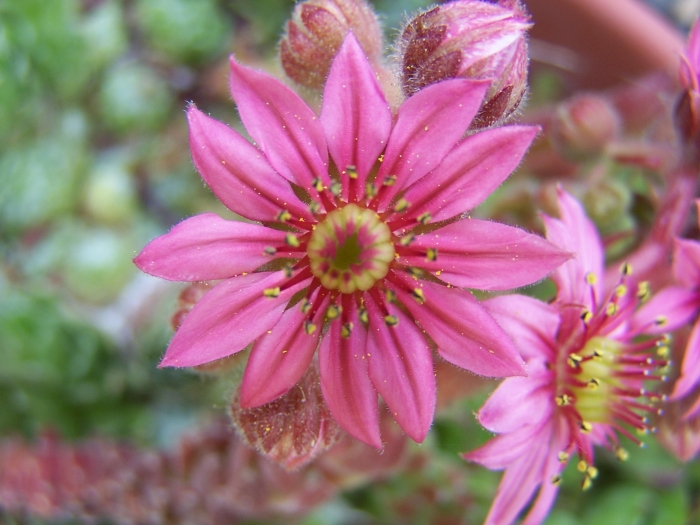Cobweb Houseleek
(Sempervivum arachnoideum)
Cobweb Houseleek (Sempervivum arachnoideum)
/
/

Little Mountain 5
CC BY-SA 3.0
Image By:
Little Mountain 5
Recorded By:
Copyright:
CC BY-SA 3.0
Copyright Notice:
Photo by: Little Mountain 5 | License Type: CC BY-SA 3.0 | License URL: https://creativecommons.org/licenses/by-sa/3.0 | Uploader: Little Mountain 5 | Publisher: Wikimedia Commons | Title: Hen_and_Chicks_Flower.jpg | Notes: {{Information |Description=''[[Cassia nemophila]]'' [[Springs Preserve]] garden, [[Las Vegas, Nevada]] |Source=self-made |Date=26 March 2006 |Author= [[User:Stan Shebs|Stan Shebs]] |Permission=see below |other_versions= }} {{Stan Shebs photo}}























































Estimated Native Range
Summary
Sempervivum arachnoideum, commonly known as the cobweb houseleek, is a perennial succulent native to European mountain regions. It thrives in rocky crevices and alpine regions, where it forms dense mats. This plant typically grows to 8 cm (3 in) tall and can spread up to 30 cm (12 in) wide. The cobweb houseleek is characterized by its rosette-forming habit and the distinctive cobweb-like structures that cover its leaves, which are adaptations to its native alpine habitat to protect from cold and intense sunlight.
The cobweb houseleek is appreciated for its unique appearance and its pink, star-shaped flowers that bloom in July on stems above the foliage. The flowers are showy and add a splash of color to rock gardens and green roofs. It is a popular choice for xeriscaping due to its drought tolerance and ability to spread via offsets, creating a ground cover that suppresses weeds. This plant is well-suited for cultivation in full sun, requiring very low to low water once established, and it prefers well-draining soils. While generally low-maintenance, it can be susceptible to root rot if overwatered or planted in poorly draining soils. It is also frost-hardy, making it a versatile addition to cold climate gardens.CC BY-SA 4.0
The cobweb houseleek is appreciated for its unique appearance and its pink, star-shaped flowers that bloom in July on stems above the foliage. The flowers are showy and add a splash of color to rock gardens and green roofs. It is a popular choice for xeriscaping due to its drought tolerance and ability to spread via offsets, creating a ground cover that suppresses weeds. This plant is well-suited for cultivation in full sun, requiring very low to low water once established, and it prefers well-draining soils. While generally low-maintenance, it can be susceptible to root rot if overwatered or planted in poorly draining soils. It is also frost-hardy, making it a versatile addition to cold climate gardens.CC BY-SA 4.0
Plant Description
- Plant Type: Succulent
- Height: 0.5-1 feet
- Width: 1.5-2 feet
- Growth Rate: Slow
- Flower Color: Pink, White
- Flowering Season: Summer
- Leaf Retention: Evergreen
Growth Requirements
- Sun: Full Sun
- Water: Very Low, Low
- Drainage: Fast
Common Uses
Bee Garden, Border Plant, Butterfly Garden, Deer Resistant, Drought Tolerant, Erosion Control, Fire Resistant, Groundcover, Low Maintenance, Potted Plant, Rock Garden, Salt Tolerant, Showy Flowers, Street Planting
Natural Habitat
rocky crevices and alpine regions
Other Names
Common Names: Spinnweben-Hauswurz, Spindelvevtakløk, Spinnenwebhuislook, Kingelvevtaklauk, Spindeltaklök, Spindelvävstaklök
Scientific Names: , Sempervivum arachnoideum, Sempervivum laggeri,
GBIF Accepted Name: Sempervivum arachnoideum L.